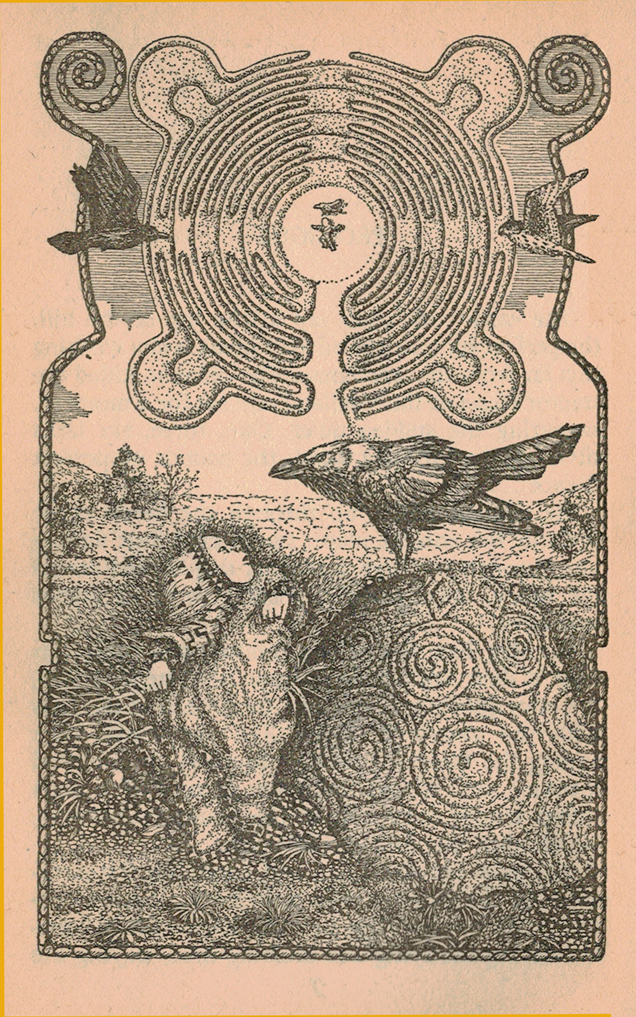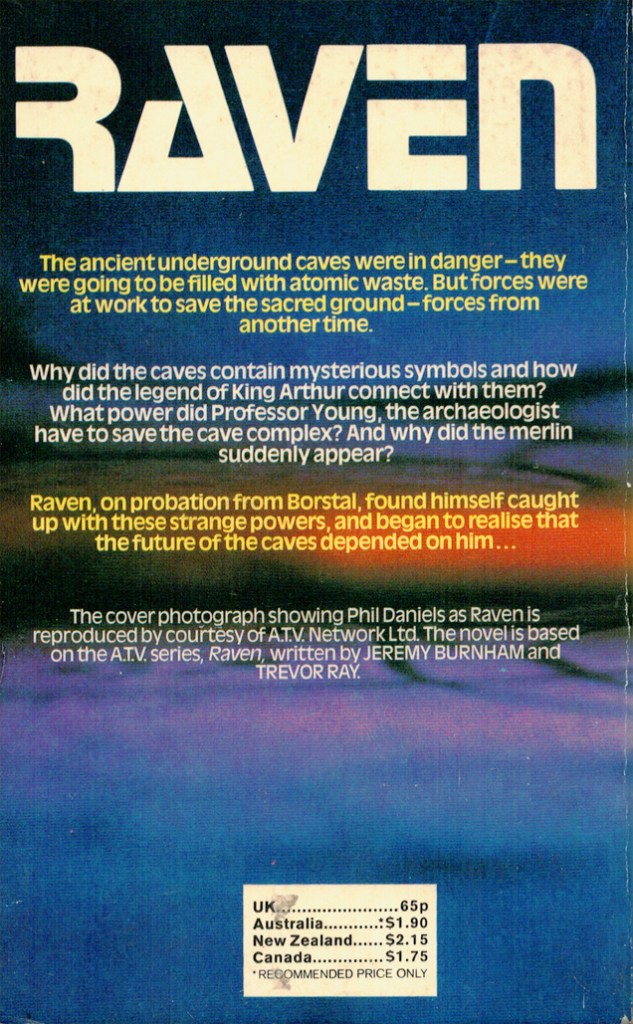Eyes down for a game of 1970s Children’s Drama Bingo! Raven, a straight novelisation of the 1977 ATV serial of the same title, boasts virtually a full house. There’s a mystical stone circle, an ancient cave system, a looming environmental tragedy, a cantankerous old professor, references to both Arthurian legend and the nebulous power of the Zodiac, and – thrown into their midst – an angry Borstal tearaway made good. Anyone now standing up excitedly, waving their card and yelling “HOUSE!”, wins a magnum of Mateus Rosé presented to them by Naomi Grant, plucky young reporter at the Midshires Herald.

I’m being flippant. Raven explores some fascinating and profound themes. Not least that of conflict: most tellingly that quintessentially 1970s battle between the powerful forces of Olde England, dormantly slumbering beneath ancient landscapes, and the onrushing stampede of unfeeling modernity that threatens to subsume them forever. So, in an unspecified nook of the spooky South-West, a prehistoric stone circle and its accompanying maze of earthworks are earmarked to be the site of a nuclear waste reprocessing plant, with the network of caves beneath – festooned with ancient animal carvings and linked in the local folklore to tales of King Arthur – destined to play host in perpetuity to the resulting radioactive waste. A fractious battle is being played out between veteran archaeologist Professor Young and his team of “long-haired weirdos” frantically racing to uncover the historic secrets of the site, and construction boss Bill Telford, whose team are already eagerly swarming into the caves.
Thrown like a fizzing firecracker into this eco-tinderbox is Raven, a snarling teenager from nearby Ferndown Borstal, offered a temporary country retreat by Professor Young and his wife Georgina as part of a rehabilitation scheme. Raven, we swiftly discover, positively thrives on confrontation, particularly revelling in opportunities to take down the uniformed or grey-suited establishment figures (probation officers, train guards, even the Youngs themselves) that he sees almost as a conspiracy of oppression against him. His unrelenting anger at the world is palpable, and incendiary. And, much to the prickly chagrin of Professor Young, he swiftly befriends Bill Telford, seeking to undermine the concerns of his new hosts at every opportunity: “Got to move with the times, Prof… this it the twentieth century, not the Dark Ages.”

And yet Raven belongs more to the Dark Ages than he suspects. As an abandoned baby, he was discovered by a local farmer on the very site of the mystical earthworks at the heart of this narrative and named after the bird lurking protectively beside him. And he has grown up entirely unaware of his extraordinary birthright: for the role of “King Arthur” is an inherited title, and Raven is its heir. Drawn by mystical forces (marshalled, it is tantalisingly suggested, by Georgina Young) he has unwittingly returned to his spiritual home to lead the battle against the crushing forces of toxic, bureaucratic modernity.
A mission that, clearly, requires something of volte face, given that Raven has already aligned himself with Bill Telford and the dreaded “powers-that-be”. But the novel’s other defining theme is that of the importance of change, and – to guide him through the transformation required to fulfill this mystical destiny – Raven is gifted the company of his own Guinevere, the aforementioned Naomi Grant. A gifted journalist and enthusiastic champion of environmental issues, Naomi is widely patronised by every lustful male character in the book, uniformly seen as little more than a pretty face (“A knockout!”) and relegated by her boorish editor to write horoscopes in the guise of the newspaper’s pseudonymous astrologer “Madame Futura”.
Noami’s interest in the Zodiac, nevertheless, proves to be to be the key to the story’s ultimate resolution: it is she, in a pivotal scene with Raven and Professor Young, who realises that the eleven ancient caves beneath the stone circle correspond to traditional astrological star-signs, and that a twelfth cave – representing Sagittarius, Raven’s sign – must lie still undiscovered. And when Raven begins to experience mystical visions centered around the astrological symbol for Pluto, Naomi recognises these hallucinations as a potent symbol of the transformation required within him. “Pluto governs change,” she explains to her eye-rolling editor. “It has the power to turn lazy, selfish lives into happy, constructive ones. Under its influence, people discover a sense of purpose.”

At this point, the book briefly feels in danger of being subsumed beneath its own sense of purpose, boldly attempting to draw connecting strands between every disparate element of the story in a dizzying cavalcade of mystical symbolism. Pluto, explains Naomi, is also linked astrologically to the “newest form of power: atomic energy”, while Professor Young cites folkloric connections between the signs of the Zodiac and King Arthur’s Round Table. It’s slightly dizzying, but never less than entertaining – and Naomi’s application of astrological insight to affect the course of a rockfall rescue mission is a brilliant curveball, a truly ingenious plot twist that even the most fervent stargazer would struggle to see coming. This dramatic development also offers up a delicious lampoon of 1970s TV mores in the shape of the slimy Clive Castle, presenter of popular current affairs programme Today People… and surely a lunchtime drinking buddy of Reggie Perrin‘s odious TV nemesis, Colin Pillock of Pillock Talk.
So it’s a rollicking story with a still-prescient message, leading to a haunting and touching conclusion centered around that mysterious twelfth cave. It’s also a hugely entertaining addition to the welter of 1970s TV and literature that unashamedly imagined the soulless superficiality of modern life being kicked up the metaphorical backside by the powers of darker, stranger forces emerging from below. Burnham and Ray, of course, explored similar themes in the extraordinary Children of the Stones, broadcast only months before Raven, thus effortlessly cornering the market in 1977 vintage weirdness for kids. And huge credit to renowned artist Les Matthews, whose intricate line illustrations throughout this book are beautifully evocative.
POINT OF ORDER: The 1977 TV series has a truly terrific cast: Phil Daniels – whose casting in teenage tearaway roles was virtually on the statute books at the time – plays the title role, with Last of the Summer Wine‘s Michael Aldridge and Carry On stalwart Patsy Rowlands teaming up as the Youngs, and future EastEnder Shirley Cheriton as Naomi. It’s available here:
https://networkonair.com/all-products/1134-raven-the-complete-series
FURTHER POINT OF ORDER: Raven goes straight onto the long list of children’s books that begin with the protagonist(s) arriving at the book’s primary location on a train. As discussed here…
MUSTINESS REPORT: 7/10. My original 1977 edition is delightfully musty, with pages that themselves seem to boast a worrying radioactive glow: what would be described on eBay as “light foxing”.